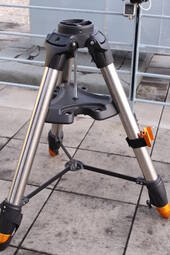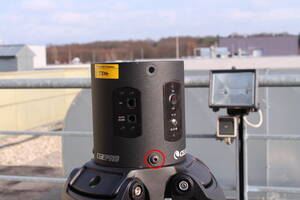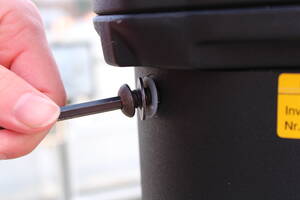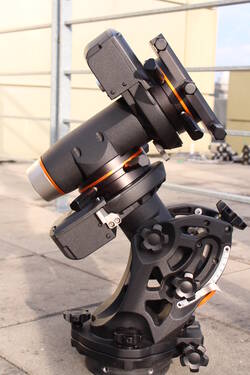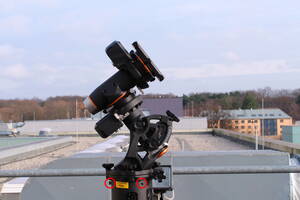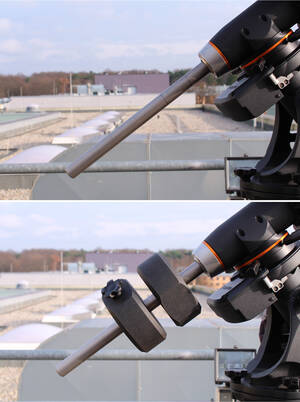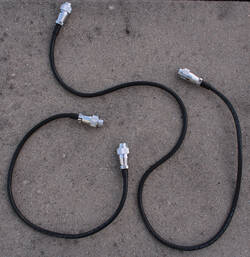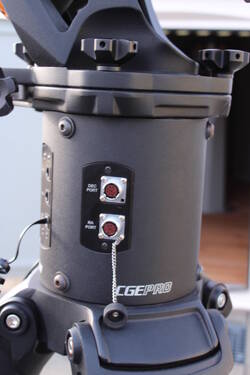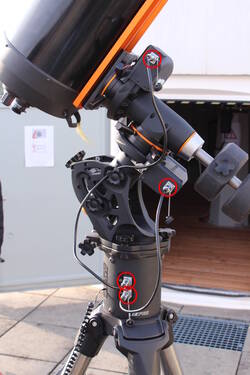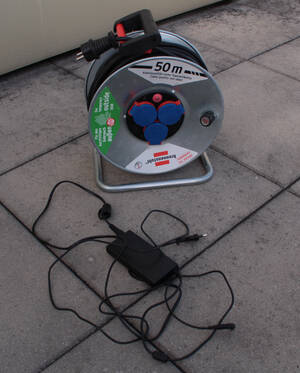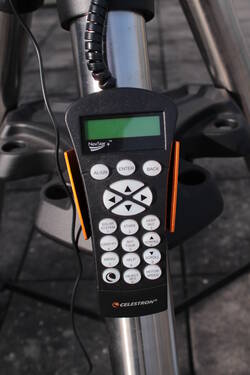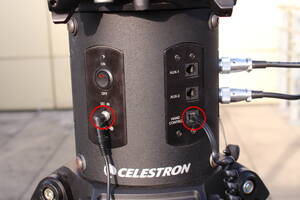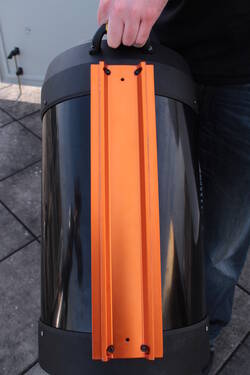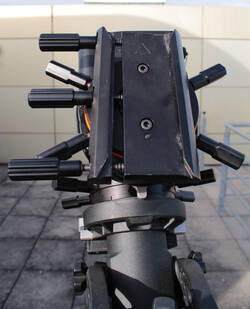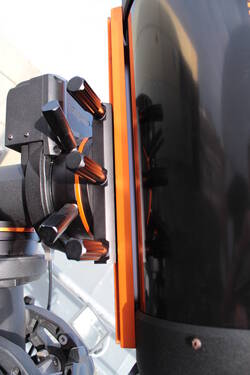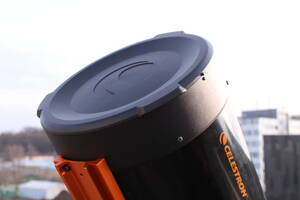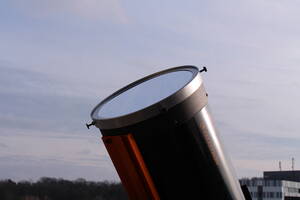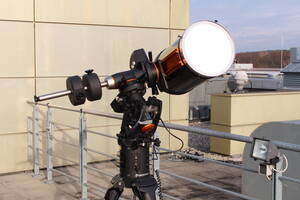This is an old revision of the document!

(remove this paragraph once the translation is finished)
C11 & CGE PRO
C11 is our second largest telescope and suitable for mobile use. For this it has to be reconstructed each time. To display and describe the details of this process is the purpose of this article.
Scattered pieces
To protect the sensitive electronics from weathering conditions they are stored in the lab course room. The remaining mechanical parts stay in the, so one must not carry them around every time.
Stored in the dome:
- the tripod
- the tube (C11)
- counterweights + bar
Stored in lab course room:
- CGE PROs electronic box
- CGE PRO mounting
- box containing all 1.4″ oculars and small pieces
- sun filter
Setup
- The CGE PRO uses a parallactic mount and has to be adjusted to the northern direction. Therefore the tripod (see figure 1) should be positioned accordingly. To do so it is usually sufficient to point the tripod leg with the carrier for the hand terminal to the south.
- Screw the counterweight bar into the mechanic and place the counterweights on it (see figure 6). When you fasten the screews on them, they are hold in place
- Connect the electronic box to the engines of the mount. The cables <see imgref cables> go in the ports on the side of the electronic box figure 8 and have different length. The short one connects to the axis controlling the rec-ascension the longer one is for the declination (see figure 9). The cable only fit in one position.
- Now you can attach an ocular, a camera or a spectrograph to the tube. To use 2″ oculars or one of the other instruments you need to exchange the 1.4″ adapter at the end of the tube by a 2″ adapter from the storage container.
- Usually a focal reducer is already attached. If you don't want to use it, it has to be exchanged and a ocular adapter.
- Before using the telescope u have to tare the rotation axis. First lose the bolts fixing the rectascension axis, until you can freely move the telescope along this axis. Now adjust the position of the counterweights such that there is now movement along this axis any more. Tighten the bolts again and repeat this procedure for the declination axis. As there are now counterweights now, to taring the declination axis shift the tube in the mounting. Again this should be done by to people
- Done! ( figure 18)
Start-up
The CGE PRO can simply switched on and off via the On/Off switch at the electronic box. In contrast to the OST, the CGE PRO does not require any shutdown procedure. It simply can be switched off. After the boot of the mount, it is almost always required to perform an alignment. The following possibilities exist:
- Two Star Align
- One Star Align
- Solar System Align
- Quick-Align
- Last Alignment
- Re-Alignment
Unfortunately, the handling of the hand terminal of the CGE PRO is not as intuitive as the one of the OST. However, after a short settling in period also an inexperienced user can safely handle this mount.
Alignment
Usually it is required to create a new alignment after each setup of the mount. If one wants to use more than one night in a row, there is the opportunity to put the mount into a hibernation mode (see below) that allow to disconnect the mount from the power supply and at the same time to conserve the alignment. If the mount is used at a fixed position, one also can make use of a saved alignment.
General procedure:
- switch on the mount
- press ENTERto start the alignment procedure
- press ENTER to allow the mount to move to the initial position (the co-called switch position)
- enter the date
- enter the time
- select Daylight Savings time or Standard time
- select the time zone (+1)
- select the alignment method
In addition to the above settings one also has to set the location after a reset of the mount to the default settings. This can be done by selecting a location from a list of known locations or by entering the latitude and the longitude.
Solar System Alignment
The Solar System Alignment is useful especially for solar observations, since one can use directly to perform the alignment. While the precision of the Solar System Alignment is lower than what one can achieve with an alignment procedure that is based on several stars, it is usually sufficient for our purposes. Before the the can be used as an alignment star, it is required to allow the telescope to actually move to the sun, since this in blocked by default for security reasons. this can be done via UTILITIES → SUN MENU → ENTER. Apart from the points mentioned above, the Solar System Alignment requires the following steps:
- select Solar System Align (with the ↑ and ↓ buttons and not with the NSWO buttons)
- select Sun in the menu and confirm it with ENTER ⇒ subsequently the telescope is moving the estimated position of the Sun
- search for the Sun and center the Sun in the eyepiece (Do not use the finderscope as suggested by the software, since we do not have a solar filter for the finderscope!)
- confirm with ENTER
- press ALIGN ⇒ Finished!
Two-Star Alignment
Das Two-Star Alignment bzw. dessen Verbesserung durch weitere Sterne ist die Standardprozedur für Nachtbeobachtungen. Neben den oben genannten Punkten müssen noch folgende Schritte durchgeführt werden:
- Two Star Align auswählen, das Teleskop schlägt daraufhin helle Sterne vor, die über den Horizont stehen
- den ersten Kalibrationsstern auswählen und mit ENTER bestätigen
- Stern im Okular zentrieren (den Sucher zu verwenden bringt in aller Regel nichts, da dieser meist nicht mit dem Tubus alignt ist)
- mit ENTER bestätigen
- ALIGN drücken, das Teleskop schlägt daraufhin den zweiten Kalibrationsstern vor
- Stern im Okular zentrieren (sollte man den Stern nicht finden kann über UNDO ein neuer Stern ausgewählt werden)
- mit ENTER bestätigen
- ALIGN drücken, das Alighnment kann anschließend durch hinzufügen weiterer Sterne verbessert werden (wenigstens 3 werden empfohlen, maximal 6 sind möglich)
- UNDO drücken um das Alighnment zu komplementieren
Hibernation
The hibernation modus offers the possibility to use the telescope several nights in a row, while switching off the power supply during the day. The hibernation procedure ensures that the alignment will be conserved. However during hibernation, it is not allowed to move the telescope at all. The following steps are necessary to put the telescope into hibernation:
- press the MENU button
- select HILBERNATE from the UTILITES menu
- move the telescope to the desired park position
- switch off the telescope
- disconnect the power supply and arrange for weatherproof cover (Important: do not move the telescope anymore!)
Wake up:
- reconnect the power supply
- switch on the telescope
- confirm Wake up with ENTER
- confirm the time and the location
- The telescope is ready for the next observation!
Troubleshooting
Known error sources and their solutions can be found here.
Additional documentation
More details on the CGE PRO and the C11 can be found in the corresponding manuals in the lab course room.
